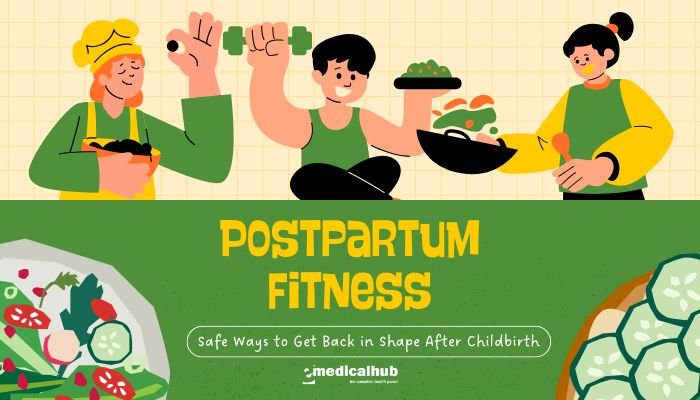Introduction
Childbirth is a remarkable feat for a woman’s body—whether the pregnancy and birth proceed with or without complications. After delivery, new mothers often wonder when and how to resume exercise safely, aiming to regain strength, manage weight, and boost overall well-being.
However, the postpartum period is a time of significant physical and emotional change. The body, having undergone the rigors of pregnancy and labor, needs gradual yet consistent support to recover.
Postpartum fitness involves more than just dropping “baby weight.” It embraces healing the core, rebuilding strength in the pelvic floor, and carefully restoring stamina. Rushing into intense exercise can lead to injuries or complications, whereas a balanced approach can improve energy levels, mental health, and physical resilience.
This article explores guidelines for reintroducing workouts after childbirth, from gentle initial movements to progressive, goal-oriented routines. We’ll also address potential challenges, including diastasis recti, pelvic floor issues, and the demands of new motherhood. With the right plan, postpartum exercise becomes an empowering journey, supporting both mother and baby for the long term.
Understanding the Postpartum Period
The “Fourth Trimester”
- Definition: Often called the fourth trimester, the postpartum phase typically covers the first 12 weeks (though can extend beyond) after delivery.
- Physical Recovery: Uterus involution (shrinking back), hormonal shifts, tissue healing at sites like the perineum or cesarean scar.
- Emotional Adjustments: Sleep deprivation, potential mood fluctuations, breastfeeding challenges, and care responsibilities.
Common Postpartum Bodily Changes
- Weakened Pelvic Floor: Carrying a baby places stress on pelvic ligaments and muscles. Vaginal delivery can further strain or injure pelvic support structures.
- Core Muscle Laxity: The abdominal wall, especially the rectus abdominis, often separates (diastasis recti) to accommodate the growing uterus.
- Breastfeeding Hormones: Elevated prolactin may prolong ligament laxity, and the body’s shape can shift with milk production.
- Energy and Nutritional Requirements: Healing demands nutrients, while caring for a newborn can reduce rest and time for self-care.
When to Start Exercising?
- Typical Guideline: Most advise waiting about 6 weeks after a normal vaginal birth (8–10 weeks for cesarean) before resuming structured exercise. However, gentle mobility and pelvic floor exercises can begin sooner.
- Medical Clearance: Each woman’s situation varies, so obtaining clearance from an obstetrician or midwife is recommended, especially after complicated births or surgeries.
Key Thought: Patience is vital. The postpartum journey is a time for healing and re-connecting with your body’s abilities, not rushing to meet external expectations.
The Benefits of Postpartum Exercise
Physical Advantages
- Core Strength Restoration: Targeted workouts help close the diastasis recti gap, reinforcing trunk stability.
- Pelvic Floor Health: Strengthening these muscles supports continence and prevents prolapse, plus improves sexual function.
- Improved Circulation and Energy: Mild to moderate exercise aids recovery, enhancing blood flow and oxygen delivery to healing tissues.
- Weight Management: Gradual calorie burning, along with balanced eating, can help address postpartum weight retention.
Mental and Emotional Well-Being
- Mood Regulation: Exercise elevates endorphins and serotonin, possibly reducing postpartum depression or anxiety symptoms.
- Stress Relief: Physical activity offers an outlet for tension, encourages better sleep quality, and fosters self-confidence.
- Sense of Achievement: Incremental fitness progress can be a welcome reminder of strength and self-care amidst new motherhood challenges.
Enhanced Functionality
- Everyday Tasks: Lifting and carrying an infant or managing household chores demands robust musculoskeletal support.
- Long-Term Health: A postpartum fitness routine sets the stage for a lifetime of healthy movement patterns.
Important Considerations Before You Begin
Diastasis Recti
- What It Is: A separation of the rectus abdominis along the midline, common as the uterus expands.
- Checking for Separation: Basic self-check: Lying supine, knees bent, lifting head slightly while feeling the gap near the navel. A separation of more than ~2 fingertips width is clinically significant.
- Exercise Modifications: Avoid intense abdominal exercises (crunches, sit-ups, planks) initially if the gap is large. Instead, focus on gentle core rehabilitation.
Pelvic Floor Dysfunction
- Symptoms: Urinary incontinence, heaviness in the vaginal area, or pelvic organ prolapse feelings.
- Early Rehab: Kegel exercises, under professional guidance, help restore control. Some might need pelvic floor physical therapy.
Postpartum Bleeding and Healing
- Lochia: Vaginal bleeding can continue for up to 4–6 weeks. Overexertion can intensify bleeding or hamper healing.
- Cesarean Scar: Minimally invasive or standard incisions require distinct healing times. Plan to protect the incision area from excessive strain.
Balancing Breastfeeding Needs
- Energy Expenditure: Nursing mothers might require extra calories.
- Comfort with Movement: Using supportive bras during workouts can prevent discomfort.
- Timing: Exercising after feeding can alleviate breast fullness or leaking.
Sleep Deprivation
- Fatigue Factor: Evaluate your energy levels. Overtraining while chronically tired can raise injury risk and compromise immunity.
- Practical Approach: Start small. Even 10–15 minutes of gentle movement is beneficial.
Note: Each postpartum journey is unique. Adjust your approach based on your body’s signals and professional advice.
Gentle Early-Stage Exercises (Weeks 1–6, or as Tolerated)
Pelvic Floor Exercises (Kegels)
- Goal: Re-establish neuromuscular control, enhance blood flow, and minimize urinary leakage.
- How-To: Contract pelvic muscles (as if stopping urination midstream) for ~5 seconds, then relax. Repeat 10–15 reps, multiple times a day.
- Progression: Over time, add variations like quick contractions or hold for 10 seconds.
Diaphragmatic Breathing
- Why: Helps re-engage core synergy, fosters relaxation, and can reduce stress.
- Technique: Inhale slowly through your nose, letting your belly expand; exhale gently, feeling the navel move inward.
Pelvic Tilts and Bridges
- Pelvic Tilts: Lying on back, knees bent, flatten lower back against the floor, then release.
- Bridges: Lift hips off the ground, engaging glutes, hold briefly, then lower. Avoid over-arch or straining the abdomen if diastasis is present.
Walking
- Simple, Effective: Short, leisurely strolls help circulation and reduce swelling.
- Gradual Increase: From 5 minutes around the block to longer walks as stamina improves.
Neck and Shoulder Mobilizations
- Reason: Carrying a newborn or hunching for feeding can cause tension.
- Exercises: Gentle neck rolls, shoulder shrugs, scapular retractions to maintain posture.
Caution: Move slowly and avoid pain. If postpartum bleeding surges or the incision area feels strained, scale back activity.
Progressing to Moderate Exercise (After 6–8 Weeks, with Approval)
Postnatal Checkup
- Six-Week Appointment: Typically, providers assess uterine involution, check if the cervix has closed, and gauge healing of any tears or incisions.
- Go-Ahead for Low Impact: If all is well, you may begin more structured workouts: mild aerobic routines, gentle strength sessions, or postpartum yoga.
Strengthening the Core Safely
- Diastasis Recti Repair: Emphasize “core engagement” exercises, such as:
- Heel Slides: Lying on back, slide one heel outward while keeping the core stable, then switch.
- Knee Folds: Lying supine, lift one bent knee at a time, focusing on minimal ab separation.
- Avoid Crunches, Planks: At least until the gap is manageable or clinically resolved with guidance.
Low-Impact Cardio
- Elliptical or Stationary Bike: Gentle on joints.
- Swimming or Water Aerobics: Great if the incision is healed, no postpartum infections, and you feel comfortable.
- Low-Impact Classes: Seek postpartum-friendly sessions if accessible.
Light Resistance Training
- Goals: Rebuild muscle mass, boost metabolism.
- Exercises: Bodyweight squats, lunges (with stable posture), overhead presses using small dumbbells.
- Format: Start with 1–2 sets, 8–12 reps at a moderate weight. Monitor form to avoid straining the back or core.
Advanced Exercise (8–12 Weeks and Beyond)
Building Intensity Gradually
- Intermediate Strength: If core is stable, you may add progressive overload (heavier weights) or more advanced moves (deadlifts, pushups, planks) but only if diastasis is closed or minimal.
- Higher-Intensity Cardio: Incorporate intervals or jogging if the pelvic floor is well recovered (no incontinence or pressure sensation).
- Group Fitness: Pilates or postpartum yoga classes can guide safer transitions to advanced movements.
Listening to the Pelvic Floor
- Watch for Leaks: If you experience urinary leakage during higher-impact moves (like running or jumping), scale back. Consult a pelvic floor physiotherapist for specialized exercises.
- Prolapse Awareness: Heaviness in the pelvic region might indicate pelvic organ prolapse. Cease high impact and see a healthcare provider promptly.
Variation in Mothers’ Recovery Timelines
- Individual Pace: Some feel ready for moderate-intense exercise by 3 months postpartum, others may prefer 6 months or more.
- Multiple Childbirths: Each postpartum is unique, especially if there are complications or repeated pregnancies close together.
Key Components of a Balanced Postpartum Fitness Routine
Cardiorespiratory Training
- At Least 150 Minutes: Per week of moderate-intensity aerobic exercise (e.g., brisk walking, light cycling).
- Incremental Gains: If 30 minutes daily is too daunting initially, break it into 10-minute bursts.
Strength and Resistance Work
- 2–3 Sessions/Week: Aim for major muscle groups—legs, chest, back, shoulders, arms, and crucially, core.
- Functional Approach: Moves that mimic real-life tasks (carrying baby, squatting to pick objects) improve daily living ease.
Flexibility and Mobility
- Gentle Stretches: Especially for hips, lower back, shoulders, and wrists, which can tighten from baby-carrying or feeding.
- Foam Rolling: Helpful in releasing muscle tension, though be gentle around the abdomen/pelvic areas postpartum.
Mind-Body Methods
- Yoga, Pilates: Emphasize alignment, breath control, posture, plus mindful muscle engagement—helpful for re-syncing the postpartum body.
- Meditation: Even 5–10 minutes fosters stress relief, which indirectly supports physical recovery.
Managing Nutrition Alongside Postpartum Fitness
Balanced Eating for Recovery and Energy
- Protein: Helps rebuild tissues, recommended ~20–30 g per meal. Lean meats, fish, legumes, dairy are good sources.
- Complex Carbs: Whole grains, fruits, vegetables for sustained energy, fiber for healthy digestion.
- Healthy Fats: Avocados, nuts, olive oil supporting hormone regulation and satiety.
- Micronutrients: Iron, calcium, vitamin D, and B vitamins often need extra focus. A prenatal or postpartum multivitamin can assist.
Caloric Intake and Breastfeeding
- Increased Demand: Nursing mothers typically burn 400–500 extra calories daily.
- Avoid Extreme Dieting: Drastic reductions hamper milk supply and maternal energy. Aim for slow, steady weight loss (0.5–1 pound/week).
- Staying Hydrated: Water or unsweetened fluids keep up milk production and maintain exercise performance.
Listening to Hunger and Fullness Cues
- Intuitive Eating: Instead of strict calorie counting, tune in to signals.
- Frequent Mini Meals: If postpartum schedule is unpredictable, smaller, nutrient-dense snacks can stabilize energy levels.
Overcoming Common Challenges
Time Constraints and Childcare
- Short Bouts of Exercise: Ten-minute intervals throughout the day can add up.
- Baby-Wearing: Gentle walking or dancing with the baby in a secure carrier can double as bonding time.
- Partner/Family Support: Sharing infant care duties to carve out a 30-minute workout or short gym session.
Motivation and Fatigue
- Set Realistic Goals: Early postpartum might revolve around healing. Celebrate small wins, like consistent gentle exercises.
- Baby Steps: Focus on feeling stronger each week, not just dropping weight.
- Find Encouragement: Join postpartum fitness communities or online groups to share progress and advice.
Fear of Injury or Making “Mistakes”
- Professional Guidance: A postpartum-certified trainer or physiotherapist can ensure safe progression, especially if diastasis recti or pelvic floor issues are present.
- Gradual Approach: Overdoing it can backfire with injuries or increased postpartum bleeding. Listen to your body’s signals.
Specific Conditions and Modifications
Diastasis Recti Rehab Approaches
- Transverse Abdominis Engagement: “Drawing in” maneuvers that gently approximate the abdominal midline.
- Avoid Crunches: At least until the gap is minimal, with correct technique.
- Physiotherapy: If the separation is severe (more than ~3 cm, or with deep tissue coning), specialized rehab is recommended.
Pelvic Floor Dysfunction
- Physical Therapy: A pelvic floor therapist can use biofeedback, manual therapy, and targeted exercises for prolapse or incontinence.
- Pessary: In some cases, vaginal support devices help maintain organ alignment if minor prolapse is present.
- Lifestyle Adjustments: Minimizing heavy lifting, controlling chronic coughing, and ensuring proper bowel habits to reduce straining.
Post-Cesarean Recovery
- Incision Protection: Start with gentle walking and core bracing to avoid pulling on the scar.
- Abdominal Binders: Sometimes used for comfort and support initially.
- Timeline: Typically 8–10 weeks or longer before more intense abdominal or strength exercises, verifying clearance from a doctor.
Tracking Progress Safely
Gauging Improvement
- Endurance Gains: Assess if daily tasks become easier, or if walking distance can be increased without fatigue.
- Measuring Strength: Gradual increments in weights or repetition count.
- Inches Lost vs. Scale: The scale might move slowly, but waist or hip measurements can reflect healthier body composition changes.
Recognizing Overtraining Signs
- Elevated Fatigue: If postpartum demands plus workouts lead to persistent exhaustion, irritability, or poor sleep, scale back.
- Musculoskeletal Pain: Unusual knee, back, or pelvic pain signals possible form issues or overuse.
- Increased LoC: Resurgence of postpartum bleeding or watery/bloody discharge might indicate overexertion.
Celebrating Milestones
- Non-Physical Markers: Improved mood, confidence, or mental clarity.
- Setting Realistic Goals: E.g., a 5K walk/run event, returning to a favored pre-pregnancy sport, or being able to do certain yoga poses comfortably.
Mindset for Sustainability
Avoiding “Bounce Back” Pressures
- Body Positivity: Recognize postpartum bodies have changed from carrying and nourishing a new life.
- Short- vs. Long-Term: Approach postpartum fitness as a healing journey, not a crash diet challenge.
- Social Media Myths: Pictures of celebrities or influencers postpartum rarely reflect the complexities of personal postpartum recovery.
Self-Compassion
- Tune In: Celebrate your body’s capabilities.
- Minimal Comparison: Each postpartum mother recovers at a unique pace—some may re-enter high-level fitness quickly, others need extended time.
- Build a Supportive Network: Loved ones or postpartum exercise classes that foster encouragement over competition.
Setting Future Health Pathways
- Preventing Chronic Issues: Strengthened core and strong pelvic floor can help avoid chronic back pain or incontinence as you age.
- Confidence in Parenting: Physical energy fosters easier child-lifting, active play, and overall family engagement.
Conclusion
Postpartum fitness is about rebuilding strength, nurturing core and pelvic floor function, and safeguarding future health. It’s a holistic process that respects the healing body—balancing rest, gentle movement, and progressive exercise intensities. By following guidelines to protect against diastasis recti, pelvic floor strain, and undue stress, mothers can find safe ways to regain stamina and vitality.
Even small, consistent efforts—like gentle walks or short pelvic floor sessions—can yield significant benefits in postpartum well-being. As weeks and months pass, incorporating moderate resistance training, mindful cardio, and a balanced diet supports healthy weight management and energy. With a flexible mindset and professional guidance where needed, postpartum women can embrace fitness goals that not only strengthen their bodies but also uplift their mental and emotional resilience. Ultimately, postpartum fitness is a journey of self-care that benefits both mother and baby, laying the foundation for a vibrant, active life in the years to come.
References
- American College of Obstetricians and Gynecologists (ACOG). Physical activity and exercise during pregnancy and the postpartum period: ACOG Committee Opinion No. 804. Obstet Gynecol. 2020;135(4):e178-e188.
- Canadian Society for Exercise Physiology. 2019 Canadian guideline for physical activity throughout pregnancy. Br J Sports Med. 2018;52(21):1339-1346.
- Kornfield SL, Goodman D, Alcantara K, et al. Return to exercise postpartum: Factors, behaviors, and outcomes. J Womens Health (Larchmt). 2020;29(11):1325-1333.
- Gluppe LS, Hilde G, Tennfjord MK, et al. Effect of a postpartum training program on the prevalence of diastasis recti abdominis in postpartum primiparous women: a randomized controlled trial. Phys Ther. 2020;100(8):1372-1381.
- Public Health Agency of Canada. Canadian 24-Hour Movement Guidelines for Adults ages 18-64 years. 2021.
- Davenport MH, Ruchat SM, Mottola MF, et al. Exercise for postnatal depression: a meta-analysis of randomized controlled trials. Obstet Gynecol. 2021;137(1):41-50.
- Rathbone EN, Manson JE. Early postpartum exercise: bridging the gap between bed rest and resuming pre-pregnancy fitness. Curr Womens Health Rep. 2019;15(2):153-160.
- Walton LM, Cotton F, Nall CR. Diastasis recti detection and the effect of postpartum rehabilitation program. J Bodyw Mov Ther. 2021;26:395-400.
- Warren L, Rance S, Hunter B. Feasibility and acceptability of evaluating a postpartum medication or supplementation for postpartum depression: a systematic review. BMC Pregnancy Childbirth. 2020;20(1):352.
- Mottola MF, Davenport MH, Ruchat SM, et al. 2019 Canadian guideline for physical activity throughout pregnancy. Br J Sports Med. 2018;52(21):1339-1346.
- International Urogynecological Association. Pelvic floor muscle training for pelvic organ prolapse and urinary incontinence. IUGA. 2020.
- Lukacz ES, Fisher B, Jelovsek JE, et al. Lifestyle interventions for postpartum weight retention. J Womens Health (Larchmt). 2019;28(12):1621-1629.
- Pelvic, Obstetric and Gynaecological Physiotherapy (POGP). Guidance on postpartum exercise for new mothers. 2021.
- Mottola MF, McLaughlin T, Giroux I. Effects of an exercise and lifestyle intervention on postpartum weight retention and mother-baby outcomes. J Matern Fetal Neonatal Med. 2021;34(5):876-884.





